Categoría "Energia"
Se han encontrado 76 Coincidencias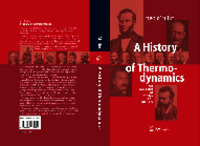
A History of Thermodynamics. The Doctrine of Energy and Entropy
67 Visitas | 83 Descargas | 2014-04-09 17:18:40 | raulito
The most exciting and significant episode of scientific progress is the development of thermodynamics and electrodynamics in the 19th century and early 20th century. The nature of heat and temperature was recognized, the conservation of energy was discovered, and the realization that mass and energy are equivalent provided a new fuel, – and unlimited power. Much of this occurred in unison with the rapid technological advance provided by the steam engine, the electric motor, internal combustion engines, refrigeration and the rectification processes of the chemical industry. The availability of cheap power and cheap fuel has had its impact on society: Populations grew, the standard of living increased, the environment became clean, traffic became easy, and life expectancy was raised. Knowledge fairly exploded. The western countries, where all this happened, gained in power and influence, and western culture – scientific culture – spread across the globe, and is still spreading.
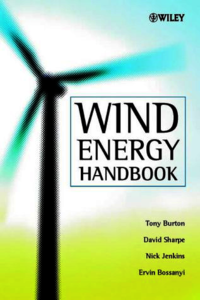
WIND ENERGY HANDBOOK
57 Visitas | 83 Descargas | 2014-04-10 16:36:15 | raulito
The use of wind energy to generate electricity is now well accepted with a large industry manufacturing and installing thousands of MWs of new capacity each year. Although there are exciting new developments, particularly in very large wind turbines, and many challenges remain, there is a considerable body of established knowledge concerning the science and technology of wind turbines. This book is intended to record some of this knowledge and to present it in a form suitable for use by students (at final year undergraduate or post-graduate level) and by those involved in the design, manufacture or operation of wind turbines. The overwhelming majority of wind turbines presently in use are horizontal-axis, land- SCOPE OF THE BOOK 7 based turbines connected to a large electricity network. These turbines are the subject of this book.

Handbook of Air Pollution from Internal Combustion Engines. Pollutant Formation and Control
56 Visitas | 57 Descargas | 2014-04-10 16:47:08 | raulito
Motor vehicles-cars, trucks, and buses-are a major source of air pollution. For 35 years we have been both learning about the problem and attempting to control vehicle emissions. In this introduction, we trace the history of our efforts to understand this important environmental issue and to find effective solutions, as well as look ahead to the future. While steady progress has been made and effective technology, such as engine controls, exhaust catalysts, and improved fuels, has been developed at the individual vehicle level, the full resolution of this problem still escapes us. Growth in vehicle use and the failure of the emission controls in a small but significant fraction of vehicles have offset a substantial part of the anticipated gains. Looking to the future, are prospects for effective emissions control better? Yes, improved fuel injection, sensors and controls, and catalyst technologies are being developed, more effective inspection programs are being implemented, and alternative fuels may play some role. However, growth in vehicle use will continue to present a major environmental challenge to both automotive engineers and regulators.
Problemas de termotecnia
63 Visitas | 120 Descargas | 2014-04-10 16:58:53 | raulito
El presente compendio de problemas de termotecnia se destina a profundizar el estudio del curso "Termotecnia" para alumnos de especialidades no energéticas de los centros de enseñanza superior.
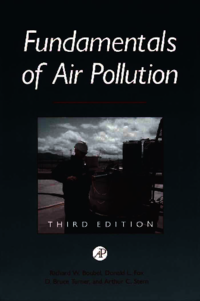
Fundamentals of Air Pollution
74 Visitas | 73 Descargas | 2014-04-10 17:06:38 | raulito
In the environmental protection and management field, the experience of the recent past has been that physicists and electrical engineers have been most attracted to the radiation, nuclear, and noise areas; biologists and civil approximates the ratio of those professionally involved in the field of air pollution. In the environmental protection and management field, the experience of the recent past has been that physicists and electrical engineers have been most attracted to the radiation, nuclear, and noise areas; biologists and civil engineers to the aquatic and solid waste areas; chemists, meteorologists, and chemical and mechanical engineers to the area of air pollution and its control. These remarks are not intended to exclude all others from the party (or from this course). The control of air pollution requires the combined efforts of all the professions mentioned, in addition to the input of physicians, lawyers, and social scientists. However, the professional mix of the authors, and their expectation of a not-too-dissimilar mix of students

Macmillan Encyclopedia of Energy. Volume 1
48 Visitas | 79 Descargas | 2014-04-10 17:15:02 | raulito
The Encyclopedia covers the major energy-using technologies and examines the advances that have been made in terms of performance and efficiency. This is an important approach because the unforeseen technology of tomorrow might be far different from what exists today, leading to an alteration in patterns of energy consumption. Only by improving how experts predict how technological innovation will alter energy consumption will we be able to avoid making erroneous energy predictions similar to those made in the 1970s. A large number of entries related to transportation are included because this sector of the economy faces the greatest challenges in the future with regard to energy use. The reliance on imported petroleum and the difficulty in switching to another energy source make the transportation sector particularly vulnerable to supply disruptions and wild price fluctuations. Subjects related to electricity are also well represented because of the rapid pace of growth in the field of electric technology.

Macmillan Encyclopedia of Energy. Volume 2
64 Visitas | 89 Descargas | 2014-04-10 17:17:31 | raulito
The Encyclopedia covers the major energy-using technologies and examines the advances that have been made in terms of performance and efficiency. This is an important approach because the unforeseen technology of tomorrow might be far different from what exists today, leading to an alteration in patterns of energy consumption. Only by improving how experts predict how technological innovation will alter energy consumption will we be able to avoid making erroneous energy predictions similar to those made in the 1970s. A large number of entries related to transportation are included because this sector of the economy faces the greatest challenges in the future with regard to energy use. The reliance on imported petroleum and the difficulty in switching to another energy source make the transportation sector particularly vulnerable to supply disruptions and wild price fluctuations. Subjects related to electricity are also well represented because of the rapid pace of growth in the field of electric technology.

Macmillan Encyclopedia of Energy. Volume 3
59 Visitas | 97 Descargas | 2014-04-10 17:19:56 | raulito
The Encyclopedia covers the major energy-using technologies and examines the advances that have been made in terms of performance and efficiency. This is an important approach because the unforeseen technology of tomorrow might be far different from what exists today, leading to an alteration in patterns of energy consumption. Only by improving how experts predict how technological innovation will alter energy consumption will we be able to avoid making erroneous energy predictions similar to those made in the 1970s. A large number of entries related to transportation are included because this sector of the economy faces the greatest challenges in the future with regard to energy use. The reliance on imported petroleum and the difficulty in switching to another energy source make the transportation sector particularly vulnerable to supply disruptions and wild price fluctuations. Subjects related to electricity are also well represented because of the rapid pace of growth in the field of electric technology.

Biomass Gasification and Pyrolysis Practical Design and Theory
60 Visitas | 55 Descargas | 2014-04-11 17:17:48 | raulito
The art of gasification and pyrolysis of biomass is as old as our natural habitat. Both processes have been at work since the early days of vegetation on this planet. Flame leaping from forest fires is an example of “flaming pyrolysis.” Blue hallow in a swamp is an example of methane gas formation through decomposition of biomass and its subsequent combustion in contact with air. Human beings, however, learned to harness these processes much later. First, large-scale application of gasification for industry and society concentrated on coal as the fuel. It was primarily for lighting of city streets and affluent people’s houses. Use of gasification, though nearly as ancient as combustion technologies, did not rise with industrialization the same as combustion because of the abundant supply and low prices of oil and natural gas.

Thermodynamic analysis of biomass gasification and torrefaction
44 Visitas | 68 Descargas | 2014-04-11 17:27:44 | raulito
fuel. The gasification of coal and biomass began in about 1800 and by about 1850 gas light for streets was commonplace. Before the construction of natural gas pipelines, there were many “gasworks” serving larger town and cities in Europe and the US. During the petroleum shortages of World War II, almost a million gasifiers were used to run cars, trucks, and buses using primarily wood as a fuel. These gasifiers were mothballed after the return to peace and the availability of inexpensive petroleum fuels. However, the oil crisis in the 1970’s and 1980’s has inspired continued research and development of coal gasifiers. Since the 1990’s, concerns about global warming shifted the focus to biomass as a gasifier fuel. Due to its higher efficiency, it is desirable that gasification becomes increasingly applied in future rather than direct combustion. Gaseous fuels can be easily distributed for domestic and industrial use, used in electricity producing devices such as engines, gas turbines and fuel cells, or for chemical synthesis of liquid fuels and chemicals.

Microsoft Word - TEXTO TERMODINAMICA AVANZADA revisado 9 febrero.doc
78 Visitas | 98 Descargas | 2014-05-08 17:34:21 | raulito
La Termodinámica es una herramienta analítica teórica y práctica que interpreta fenómenos naturales desde el punto de vista de las relaciones materia y energía. La palabra Termodinámica fue utilizada por primera vez en 1850 por W. Thomson (Lord Kelvin) como combinación de los vocablos griegos "termo” (calor) y “dinamos” (potencia o fuerza). La Termodinámica estudia el intercambio de energía en sus diversas formas, su interacción con los equipos, las propiedades de la materia y el uso racional de la energía. Dado que no se puede concebir industria sin uso de energía, esta ciencia tiene una gran importancia práctica y se aplica en todas las ramas de la ingeniería.

Photovoltaic Systems Engineering, Second Edition
Engineering, Computing & Technology
58 Visitas | 74 Descargas | 2014-05-29 03:08:33 | raulito
The goal of the first edition of this textbook was to present a comprehensive engineering basis for photovoltaic (PV) system design, so the engineer would understand the what, the why and the how associated with electrical, mechanical, economic and aesthetic aspects of PV system design. The first edition was intended to educate the engineer in the design of PV systems so that when engineering judgment was needed, the engineer would be able to make intelligent decisions based upon a clear understanding of the parameters involved. This goal differentiated this textbook from the many design and installation manuals that are currently available that train the reader how to do it, but not why. Widespread acceptance of the first edition, coupled with significant growth and new ideas in the PV industry over the 3 years since its publication, along with 3 additional years of experience with PV system design and installation for the authors, has led to the publication of this second edition. This edition includes updates in all chapters, including a number of new homework problems and sections that cover contemporary system designs in significant detail. The book is heavily design-oriented, with system examples based upon presently available system components (2003). While the primary purpose of this material is for classroom use, with an emphasis on the electrical components of PV systems, we have endeavored to present the material in a manner sufficiently comprehensive that it will also serve the practicing engineer as a useful reference book.

Handbook of Photovoltaic Science and Engineering
74 Visitas | 73 Descargas | 2014-05-29 03:18:37 | raulito
You are reading a book about a technology that has changed the way we think about energy. Solar electricity, also known as photovoltaics (PV), has shown since the 1970s that the human race can get a substantial portion of its electrical power without burning fossil fuels (coal, oil or natural gas) or creating nuclear fission reactions. Photovoltaics helps us avoid most of the threats associated with our present techniques of electricity production and also has many other benefits. Photovoltaics has shown that it can generate electricity for the human race for a wide range of applications, scales, climates, and geographic locations. Photovoltaics can bring electricity to a rural homemaker who lives 100 kilometers and 100 years away from the nearest electric grid connection in her country, thus allowing her family to have clean, electric lights instead of kerosene lamps, to listen to a radio, and to run a sewing machine for additional income. Or, photovoltaics can provide electricity to remote transmitter stations in the mountains allowing better communication without building a road to deliver diesel fuel for its generator. It can help a major electric utility in Los Angeles, Tokyo, or Madrid to meet its peak load on hot summer afternoons when air conditioners are working full time. It allows homes and businesses a new level of guaranteed energy availability and security, and photovoltaics has been powering satellites orbiting the Earth or flying to Mars for over 30 years.

Compressed Air Manual
59 Visitas | 62 Descargas | 2014-05-29 03:32:40 | raulito
The Compressed Air Manual is a resource for everyone who wishes to know more about compressed air. This edition, the sixth, is in many respects extended, updated and improved compared to previous editions, of which the last was issued in 1976. Naturally a great deal has happened during these twenty or more years, nevertheless the fundamentals remain and make up the core of this Manual, which has been desired and requested by many.

Válvulas Selección, uso y mantenimiento
76 Visitas | 94 Descargas | 2014-05-29 03:38:48 | raulito
Las válvulas, incluso los dispositivos para desahogo (alivio) de presión, son una de las partes básicas en una planta en la industria de procesos químicos. En este volumen aparece una serie de consejos prácticos relacionados con las válvulas. Este libro se preparó para todos los que tienen alguna relación con las válvulas, sean diseñadores, ingenieros de proyecto, ingenieros de proceso o las personas encargadas de su mantenimiento. Con tantos estilos y opciones disponibles, ¿C ómo se puede hacer la elección atinada cuando se especifica una válvula.' ¿Cómo se determina el tamaño de las válvulas de desahogo? ¿Cuándo se debe seleccionar una válvula de accionamiento manual? Y, en tal caso , ¿de qué tipo ? Las respuestas a éstas y cientos de otras preguntas prácticas se encuentran en este libro. Se incluyen desde los aspectos básicos del funcionamiento hasta la operación y mantenimiento de las válvulas.

Practical Centrifugal Pumps
91 Visitas | 103 Descargas | 2014-05-29 03:42:43 | raulito
This books covers the essentials of pump construction, design applications, operations, maintenance and management issues and the authors have tried to provide you with the most up-to-date information and best practice in dealing with the subject. Key topics which the book homes in on are: the various types of centrifugal pumps; relevant pump terminology; pump characteristics and pump curves; pump calculations; auxiliary equipment associated with pumping circuits; operating pump systems – drafting the correct perations, controls and procedures; pump reliability definition in terms of availability, criticality and wear characteristics; pump efficiency – capital, maintenance and life cycle costs.
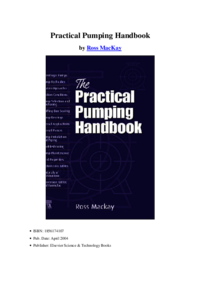
The Practical Pumping Handbook
68 Visitas | 99 Descargas | 2014-05-29 03:44:42 | raulito
A pump is an item of mechanical equipment that moves liquid from one area to another by increasing the pressure of the liquid to the amount needed to overcome the combined effects of friction, gravity and system operating pressures. In spite of the wide divergence of pump types available, over 80% of all pumps used in industry are of the single stage, end suction, centrifugal pump. The centrifugal pump moves liquid by rotating one or more impellers inside a volute casing. The liquid is introduced through the casing inlet to the eye of the impeller where it is picked up by the impeller vanes. The rotation of the impeller at high speeds creates the centrifugal force that throws the liquid along the vanes, causing it to be discharged from its outside diameter at a higher velocity. This velocity energy is converted to pressure energy by the volute casing prior to discharging the liquid to the system.

PNEUMATIC HANDBOOK
47 Visitas | 67 Descargas | 2014-05-29 03:47:10 | raulito
Elsevier Science present the latest edition of this comprehensive work on all aspects of compressed air. There have been many advances in hydraulic and electric technology in recent years, yet compressed air still keeps its place as an important medium for power generation, transmission, and control. Its versatility makes it the ideal choice for many applications for which no other form of power is as suitable. As in previous editions, the PNEUMATIC HANDBOOK covers the whole range of pneumatic engineering in one volume. It starts with the basic principles and properties of air and includes the theory of air compression, the principles of air treatment and the design of compressors, tools, machinery, actuators, sensors and valves. Low pressure and vacuum applications are also covered.

AHORRO DE ENERGIA EN SISTEMAS TERMOMECANICOS
78 Visitas | 97 Descargas | 2014-05-29 03:53:11 | raulito
Las bombas, los ventiladores y los compresores han tenido y tienen un papel decisivo en el desarrollo de la humanidad. No es posible imaginar los modernos procesos industriales y la vida en las grandes ciudades sin la participación de estos equipos. Están presentes en las grandes centrales termoeléctricas, en las empresas de procesos químico donde resultan buenos ejemplos las empresas de fertilizantes y las refinerías de petróleo, en las industrias alimenticias tales como combinados lácteos, fábricas de refrescos, maltas y cervezas. Están presentes también en los equipos automotores y de izajes de cargas. Tiene un decisivo papel en el confort de los grandes asentamientos humanos con el suministro de agua, evacuación de residuales y suministro de aire acondicionado. Los equipos de bombeo en particular son decisivos en los sistemas de riegos para la producción agrícola de alimentos. Las bombas, ventiladores y compresores transforman la energía mecánica que reciben del motor en energía del fluido. Se denominan bombas a los equipos que trasiegan fluidos incompresibles (densidad ?=constante) y ventiladores, soplantes y compresores cuando el fluido es compresible (densidad ? = variable) La cantidad de bombas, ventiladores y compresores de distintos tipos producidos hoy por las industrias de los países de más desarrollo supera los millones de unidades por años. La explotación de estos equipos requiere una parte considerable del balance energético nacional. “En Estados Unidos el 24% de la energía se utiliza en equipos de bombeo”1. En México los equipos de bombeo consumen el 22 % de la electricidad total generada en al país, y representan el 22 % del consumo de energía en el sector industrial.
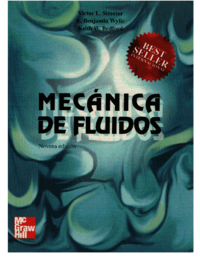
MECÁNICA DE FLUIDOS
137 Visitas | 124 Descargas | 2014-06-09 19:33:14 | raulito
En esta, la novena edición. Se han hecho un gran número de cambios importantes al texto en cuanto a su alcance, organización, enfoque y a las habilidades requeridas. El alcance del texto se ha ampliado para incluir el transporte de calor y de masa. Por consiguiente, se han añadido dos nuevos capílulos sobre los fundamentos y las aplicaciones del transporte y se han ampliado los capítulos concernientes a las propiedades, las ecuaciones básicas, el análisis dimensional y las mediciones para cubrir el material relevante sobre transporte. Con este nuevo material ahora es posible enseñar dos cursos introductorios completos de penúltimo y último año de carrera, uno en mecánica de fluidos y otro en fenómenos de transporte. Otros cambios importantes en contenidos incluyen la eliminación del capítulo sobre flujos compresibles, la combinación del flujo permanente y no permanente en tuberías, en un capítulo actualizado, la separación del capíiulo de ecuaciones rectoras en uno para las ecuaciones de volumen de control y en otro para los métodos de ecuaciones de continuo, un capítulo revisado en métodos de medición y la incorporación de casi 400 problemas nuevos.
Contribuir
Usted puede contribuir con Libros UCLV, es importante para nosotros su aporte..
Contribuir